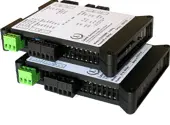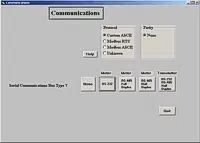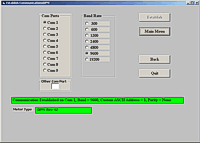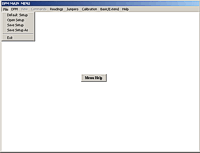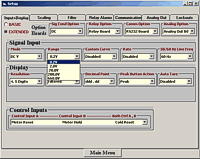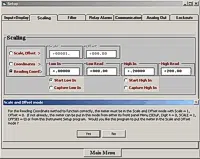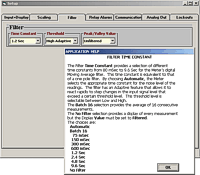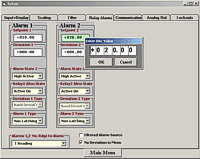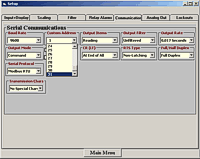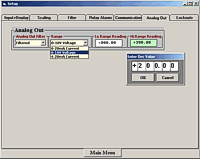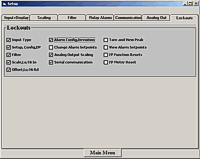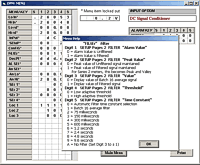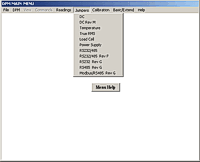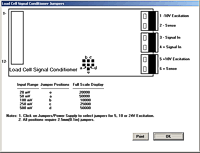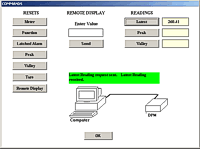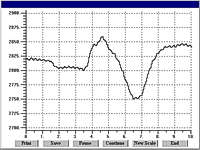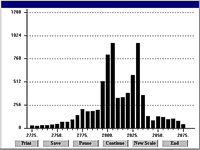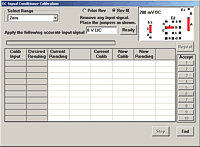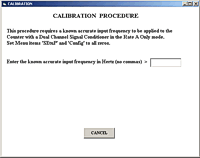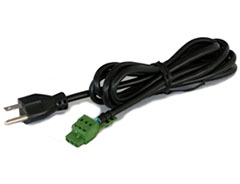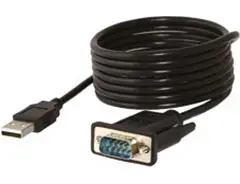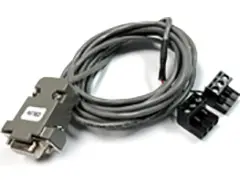- Description
- Quick Selector Guide
- Specifications
- Setup Software
- Mechanical
- Documents
- Applications
- Accessories
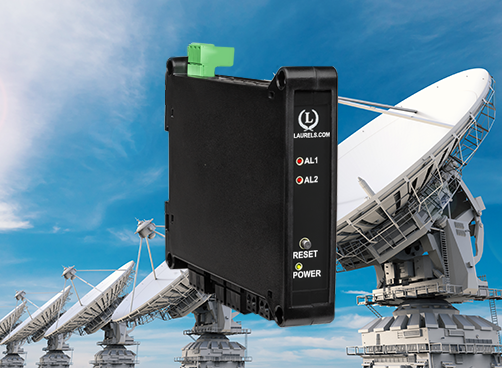
Features
- Accepts low-level differential or single-ended 5V logic level signals from shaft encoders, linear encoders, incremental encoders or optical encoders
- Programmable for position, angle or rate
- Maximum pulse rates of 250 kpulses/sec at X1, 125 kpulses/sec at X2, 62.5 kpulses/sec at X4
- Zero channel input
- 4-20 mA, 0-20 mA, 0-10V or -10V to +10V transmitter output, (isolated)
- Analog output resolution 0.0015% of span, accuracy ±0.02% of span
- Ethernet data I/O, Modbus TCP
- Dual 120 mA solid state relays for alarm or control (isolated)
- 5V, 10V, 12V, or 24V dc transducer excitation output (isolated)
- Power 85-264 Vac / 90-300 Vdc or 10-48 Vdc / 12-32 Vac (isolated)
- DIN rail mount housing, 22.5 mm wide, detachable screw-clamp connectors
- Operating temperature from -40°C to 70°C (-40°F to 158°F)
Optional - Extended supports a range of ±999,999 for reading bidirectional rate or position from shaft encoders, though not simultaneously
The Laureate™ LTE Series DIN rail analog transmitter with ethernet communication and analog outputs for versatile connectivity.
The digitally programmable transmitter features two relays for alarm or control. The series offers exceptional accuracy with Input frequencies from 0.005 Hz to 1 MHz. The LTE Series transmitters offer the same high performance, signal conditioning, and programmable features as Laureate digital panel meters, counters, and timers.The Laureate 4-20 mA, 0-20 mA, 0-10V or -10V to +10V and ethernet output transmitter for quadrature accepts A & B quadrature encoder signals to provide an analog output that tracks position, length, angle, or rate. The A & B quadrature signals are 90° out of phase, and their phase relationship determines whether up counts (+) or down counts (-) are produced.
One, two or four quadrature transitions may be counted at a maximum combined rate of 250 kHz and be scaled internally to ±999,999 counts. The input circuitry may be jumpered for either single-ended input signals or for balanced line driver signals. Anti-jitter circuitry eliminates errors produced by vibration of the encoder. In the event of a power failure, the latest total may be stored in non-volatile memory and can be used as the starting point for counting when power resumes. Power fail or zero index capabilities are alternate transmitter setup choices.

A zero index pulse, if available, is interpreted as indicating a zero reference for an integral number of revolutions of a rotary shaft encoder or the home position of a linear encoder. It is used by the transmitter for initializing and to correct for any cumulative pulse count errors. Special circuitry corrects for width of the zero index pulse.
Bidirectional Total or Rate
- With the Standard main board, the transmitter totalizes the quadrature counts and then scales the total in software for the output. A zero index Z signal can be added as a third input to the A & B signals. The analog output is generated by an ultra-linear 16-bit (65,536 step) digital-to-analog converter (DAC) for 0.02% output accuracy.
- With the Extended main board, the transmitter can be programmed to output either total or rate or rate. For example, the output can track the speed of a moving slab from the RPM of a roller. The update rate for rate is a programmed gate time + 30 ms + 0-2 pulse periods.
Unidirectional Total and Rate
If the counts are only for one direction, for example for extrusions measured by an encoder wheel, only the encoder's "A" channel can be used and be output to an Extended Laureate totalizer transmitter. This model accommodates very high pulse rates up to 1 MHz, and unlike the quadrature transmitter, it can simultaneously track rate and total.
The optional extended Laureate computer board can display rate based on successive readings. It also allows exceptionally accurate custom curve linearization, for example to read out liquid volume or rate of flow in a horizontal cylindrical tank based on level reported by a 4-20 mA transmitter. For setup, up to 180 data points can be input into a computer spreadsheet or text file by the user. The computer then calculates spline-fit segments, which are downloaded into the transmitter.
Exceptional Accuracy and Stability. Laureate transmitters determine frequency by taking the inverse of period as measured with a calibrated quartz crystal time base. This results in extremely accurate and stable 6-digit internal readings (±999,999 counts), which are then processed in software. The analog output is generated by an ultra-linear 16-bit (65,536 step) digital-to-analog converter (DAC) for 0.02% output accuracy. The update rate of the transmitter output is a programmed gate time + 30 ms + 0-2 signal periods. For a 60 Hz signal, the update rate would be 20 per second. Such fast update rates are ideal for alarm and control.
The update rate of the transmitter output is a programmed gate time + 30 ms + 0-2 signal periods. For a 60 Hz signal, the update rate would be 20 per second. Such fast update rates are ideal for alarm and control.
All signal conditioner board ranges are factory-calibrated, with calibration factors for each range securely stored in an onboard EEPROM. These factors can be scaled via software to accommodate external shunts, enabling field replacement of signal conditioner boards without necessitating recalibration of the associated transmitter. For optimal accuracy, factory recalibration is recommended annually. All Laurel Electronics instruments undergo factory calibration using the industry-leading Fluke calibrators, which are recalibrated yearly and certified traceable to national standards, ensuring the highest level of precision and reliability.
Laureate Transmitters are easily programmed with Laurel’s free Instrument Setup Software, downloadable from our website and compatible with Windows PCs, requiring a data interface board for setup.
Standard Features of Laureate LTE Transmitters Include:
- Ethernet I/O, (isolated). The supported protocols are Modbus RTU and ASCII, which are tunneled via Modbus TCP. Note that RS232 or RS485 data I/O is provided by Laurel's LT Series transmitters.
- 4-20 mA, 0-20 mA or 0-10V analog transmitter output, (isolated), jumper-selectable and user scalable. All selections provide 16-bit (0.0015 ) resolution of output span and 0.02% output accuracy of a reading from -99,999 to +99,999 counts that is also transmitted digitally. Output isolation from signal and power grounds eliminates potential ground loop problems. The supply can drive 20 mA into a 500 ohm (or lower) load for 10V compliance, or 10V into a 5K ohm (or higher) load for 2 mA compliance.
- Dual-channel pulse inputs for voltage signals, NPN or PNP proximity switches, contact closures, magnetic pickups or flow meters.
- Dual solid state relays, (isolated). Available for local alarm or control. Rated 120 mA at 130 Vac or 180 Vdc.
- Selectable transducer excitation output, (isolated), user selectable 5V@100 mA, 10V@120 mA, 12V@100 mA or 24V@50 mA.
- Power 85-264 Vac, (isolated), low-voltage 10-48 Vdc or 12-32 Vac power is optional.
Digital signal filtering modes can be selected to ensure stable readings in electrically noisy environments.
- An unfiltered selection provides true peak and valley readings and aids in control applications.
- A batch average filter selection averages each 16 conversions.
- An adaptive moving average filter selection provides a choice of 8 time constants from 80 ms to 9.6 s. When a significant change in signal level occurs, the filter adapts by briefly switching to the shortest time to follow the change, then reverts back to its selected time constant. An Auto setting selects the time constant selection based on signal noise.
Peak and valley values are automatically captured. These may be displayed via Laurel's free Instrument Setup Software, which runs on a PC under MS Windows or can be transmitted as serial data.
Two control inputs (CMOS/TTL levels, logic 0 = tied to digital ground, logic 1 = open) or dry contacts that can be set to control / activate 14 transmitter commands.
An (isolated) 5, 10, 12, or 24 Vdc excitation output is standard to power transducers or two-wire transmitters. Ratiometric operation, which automatically compensates for changes in the applied excitation, is jumper selectable for applications, such as bridges, where the signal to be measured is proportional to the excitation level.
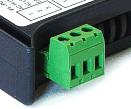
LTE series DIN rail transmitters & signal conditioners can be interfaced to a wide range of sensors and transducers using one of seven available plug-in signal conditioner boards. The transmitters duplicate the high performance (high accuracy, high read rate) and extensive programmable features of Laureate 1/8 DIN digital panel meters, counters and timers. They utilize the same signal conditioners boards, much of the same firmware, and Laurel's free Windows-based Instrument Setup Software. They come in a compact DIN rail mount package with detachable screw-clamp connectors for easy wiring.
The LTE series Transmitters accessible from this page include a 4-20 mA, 0-20 mA, 0-10V, or -10V to +10V analog output (isolated, user selectable), an ethernet serial data interface (isolated, user selectable), and dual 120 mA solid state AC/DC relays (isolated). An (isolated) 5, 10, 12, or 24 Vdc transducer excitation output is included with all models other than those with a temperature or AC RMS signal conditioner.
Connecting Laureate LTE Transmitters to a Local Area Network (LAN)
Laurel LTE series Ethernet transmitters can connect directly to a LAN via an Ethernet cable. Up to 30 Laureate LT Transmitters and/or Digital Panel Meters can be configured for RS485 and daisy-chained to an LT Transmitter for seamless LAN integration. Setup for both configurations is streamlined using Laurel’s free Instrument Setup Software, which simplifies node discovery and transmitter configuration.
Flexible Communication Options for LTE Transmitters
Laureate Transmitters can be equipped with Laurel communication boards to support various interfaces and protocols. These include serial interfaces with ASCII or Modbus RTU protocols, and Ethernet interfaces with web access, ASCII, or Modbus TCP/IP protocols, ensuring versatile connectivity for your commercial applications.
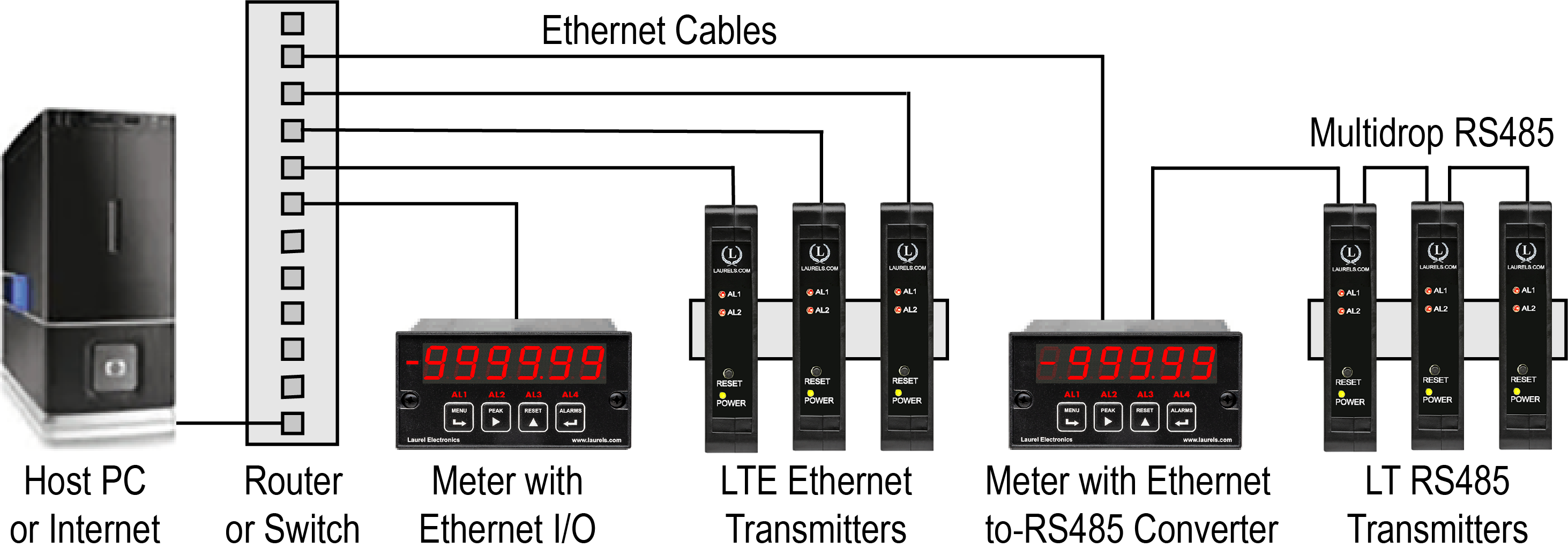
| LTE Transmitter Signal Input & Function | Model Series | Analog Output | Ethernet I/O | Dual Relays | |
|---|---|---|---|---|---|
| 1 | DC Input Voltage and Current | LTE-DC |  |
 |
 |
| 2 | AC RMS Voltage or Current | LTE-RMS |  |
 |
 |
| 3 | Process Voltage or Current | LTE-P |  |
 |
 |
| 4 | Strain Gauge or Potentiometer Follower | LTE-SG |  |
 |
 |
| 5 | Weighing Applications | LTE-WA |  |
 |
 |
| 6 | Load Cell & Microvolt Signals | LTE-WM |  |
 |
 |
| 7 | Thermocouple (Types J, K, T, E, N, R, S) | LTE-TC |  |
 |
 |
| 8 | RTD Temperature | LTE-RTD |  |
 |
 |
| 9 | Resistance in Ohms | LTE-R |  |
 |
 |
| 10 | Frequency, Rate, Speed | LTE-FR |  |
 |
 |
| 11 | Pulse Input Totalizer | LTE-FR |  |
 |
 |
| 12 | Process Signal Totalizer | LTE-VF |  |
 |
 |
| 13 | Batch Controller Analog Input | LTE-FR |  |
 |
 |
| 14 | Batch Controller Pulse Input | LTE-FR |  |
 |
 |
| 15 | Sum, Difference, Ratio, Product of 2 Inputs | LTE-FR |  |
 |
 |
| 16 | On/Off Duty Cycle | LTE-FR |  |
 |
 |
| 17 | Stopwatch Timing for Single Events | LTE-FR |  |
 |
 |
| 18 | Average Time of Periodic Events | LTE-FR |  |
 |
 |
| 19 | AC Phase Angle and Power Factor | LTE-FR |  |
 |
 |
| 20 | Quadrature Position or Rate | LTE-QD |  |
 |
 |
Laureate™ Ethernet & 4-20 mA Output Transmitter for Position or Rate from Quadrature Encoders
| Quadrature Inputs | ||||
|---|---|---|---|---|
| Type | Differential or single-ended quadrature | |||
| Transitions Monitored | x1, x2 or x4 | |||
| Max Pulse Rate | 250 kpulses/sec at X1, 125 kpulses/sec at X2, 62.5 kpulses/sec at X4 | |||
| Internal Counts | -999999 to +999999 | |||
| Position Error | No error contributed by transmitter | |||
| Differential High Theshold | +200 mV | |||
| Differential Low Threshold | -200 mV | |||
| Differential Limits | -11V to +14V | |||
| Single-ended High Voltage | 2.5V to 10V | |||
| Single-ended Low Voltage | -1V to +1V | |||
| Input Resistance, Typ. | 17 kOhm | |||
| Recalibration: All ranges are calibrated at the factory. Recalibration is recommended every 12 months. | ||||
| Quadrature Position Mode | ||||
| Zero Adjust | -999999 to +999999 | |||
| Span Adjust | 0 to ±999999 | |||
| Quadrature Rate Mode | ||||
| Conversion Technique | Inverse period | |||
| Output Update Rate | 30 ms + 0-2 signal periods | |||
| Gate time | Selectable 10 ms to 199.99 s | |||
| Time Before Zero Output | Selectable 10 ms to 199.99 s | |||
| Time Base Accuracy | Calibrated to ±2 ppm | |||
| Zero Adjust | -999999 to +999999 | |||
| Span Adjust | 0 to ±999999 | |||
| Analog Output (standard) | ||||
| Output Levels | 4-20 mA and 0-10 Vdc (selectable) | |||
| Compliance, 4-20 mA | 10V (0-500 ohm load) | |||
| Compliance, 0-10V | 2 mA (5 kOhm load) | |||
| Output Resolution | 16 bits (65,536 steps) | |||
| Output Accuracy | ±0.05% of output span | |||
| Output Update Rate | 25/sec max | |||
| Output Isolation | 250V rms working, 2.3 kV rms per 1 minute test | |||
| Ethernet Data I/O (standard) | ||||
| Type | 10/100 Base-T Ethernet per IEEE 802.3 | |||
| Data Rates | 300, 600, 1200, 2400, 4800, 9600, 19200 baud | |||
| Output Isolation | 250V rms working, 2.3 kV rms per 1 min test | |||
| Serial Protocol | Modbus TCP | |||
| Modbus Compliance | Modbus over Serial Line Specification V1.0 (2002) | |||
| Digital Addresses | 247 | |||
| Dual Relay Output (standard) | ||||
| Relay Type | Two solid state relays, SPST, normally open, Form A | |||
| Load Rating | 120 mA at 140 Vac or 180 Vdc | |||
| Excitation Output (standard) | ||||
| 5 Vdc | 5 Vdc ± 5%, 100 mA (jumper selectable) | |||
| 10 Vdc | 10 Vdc ± 5%, 120 mA (jumper selectable) | |||
| 12 Vdc | 12 Vdc ± 5%, 100 mA (jumper selectable) | |||
| 24 Vdc | 24 Vdc ± 5%, 50 mA (jumper selectable) | |||
| Output Isolation | 50 Vdc from signal ground | |||
| Power Input | ||||
| Standard Power | 85-264 Vac or 90-300 Vdc | |||
| Low Power Option | 10-48 Vdc or 12-32 Vac | |||
| Power Frequency | DC or 47-63 Hz | |||
| Power Isolation | 250V rms working, 2.3 kV rms per 1 min test | |||
| Power Consumption | 2.5W typical at 24V, 4.0W with max excitation output | |||
| Environmental | ||||
| Operating Temperature | -40°C to 70°C (-40°F to 158°F) | |||
| Storage Temperature | -40°C to 85°C (-40°F to 185°F) | |||
| Relative Humidity | 95% at 40°C, non-condensing | |||
| Cooling Required | Mount transmitters with ventilation holes at top and bottom. Leave 6 mm (1/4") between transmitters, or force air with a fan. | |||
| Mechanical | ||||
| Enclosure | Rugged black polycarbonate housing material | |||
| Mounting | 35 mm rail per DIN EN 50022 | |||
| Dimensions | 129 x 104 x 22.5 mm case | |||
| Connectors | Detachable screw clamp connectors meet VDE / IEC / UL / CSA standards. RJ45 jack for Ethernet | |||
| Tightening Torque | Screw terminal connectors: 5 lb-in (0.56 Nm) | |||
| Weight | Complete transmitter: 183 g (6.5 oz) | |||
| General | ||||
| Programming | Utilize Laurel's free Instrument Setup Software, which runs on a PC under MS Windows. | |||
| Security | Lockout options available using Laurel's free Instrument Setup Software. | |||
| Warranty | 3 years parts & labor | |||
| Recalibration: All ranges are calibrated at the factory. Recalibration is recommended every 12 months. | ||||
Transmitter Pinout
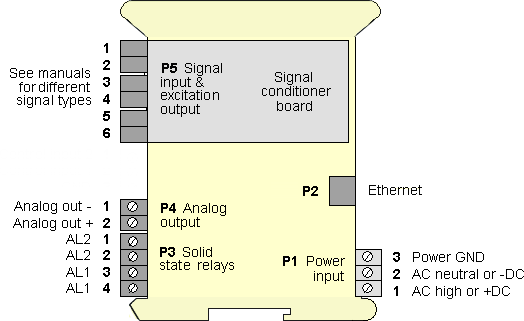
Free Instrument Setup Software for Series 2 Laureates
Free Downloadable Windows-based Instrument Setup (IS) software (Data Interface Board Required) for use with our programmable Digital Panel Meters, Scale Meters, Counters, Timers, Remote Displays, and Transmitters, are an easy method to set up Laureate 1/8 DIN digital panel meters, counters, timers, remote displays, and DIN-rail transmitters, as explained in the Instrument Setup Software Manual. Laureate 1/8 DIN instruments can also be set up from the front panel, as explained in their respective Owners Manuals. Instrument Setup software is of benefit whether or not the PC is connected to the instrument.
- When the PC is connected to the instrument, Instrument Setup software can retrieve the setup file from the instrument or open a default setup file or previously saved setup file from disk View Setup, then provides graphical user interface (GUI) screens with pull-down menus applicable to input, display, scaling, filtering, alarms, communications, analog output, and front panel lockouts. Fields that are not applicable to the instrument as configured are either left out or grayed out. Clicking on any item will bring up a detailed Help screen for that item. After editing, the setup file can be downloaded, uploaded to the instrument, or saved to a disk. The same setup file can then be downloaded into multiple instruments.
- When the PC is not connected to the instrument, the above GUI screens can be used to set up a virtual instrument. The setup file can then be saved to disk. Switching toView Menu then brings up a screen with the required front panel programming steps. This view can be printed out for use at the instrument site and to serve as a hard copy record.
Download Free Instrument Setup Software
Installation
Set User Account Control (UAC) of MS Windows to "Never notifiy me" so that Instrument Setup Software can create directories. The UAC change screen can be reached as follows:
- Under Windows 7, click on the Windows Start button in the lower left of the desktop and enter "UAC" in the search field.
- Under Windows 8, navigate to Control Panel, then to the "User Accounts and Family Safety" section, and click on "Change User Account Control Settings."
- Under Windows 10, click on the Windows Start button in the lower left of the desktop, then on "Settings", and enter "UAC" in the search field.
- Reboot your computer for the changed UAC setting to take effect.

RJ11-to-DB9 cable with rear view of DB9 connector to PC
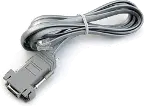
RS232 cable, meter to PC, P/N CBL01
Laureate 1/8 DIN Laureate instruments must be equipped with a serial communications board and be connected to the computer via a serial communications cable. The connection can be via RS232, RS485, USB or Ethernet. Following setup, the serial communications board may be removed from the instrument if desired. The wiring of the RS232 cable is illustrated above with end views of the two connectors.
Laureate LT Series transmitters come standard with a 3-wire serial interface, which can be jumpered for RS232 or RS485.
Laureate LTE Series transmitters come standard with an Ethernet interface.
Meter Setup Screens
Click on any of the reduced screens below for a full-size screen view, then click on the Back button of your browser to return to this page. The screens examples below are for a fully-loaded Series 2 Digital Panel Meter (DPM), which is connected to the PC via RS232. If the meter is a Series 1 meter (pre-2007), this is sensed by the software, and somewhat different screens are brought up. Please see Series 1 setup screens.











Meter Setup Utilities




From the Main Menu, click on Readings if your PC is connected to the meter. A pull-down menu then offers three choices: List, Plot and Graph.
- List presents the latest readings in a 20-row by 10-column table. Press Pause at any time to freeze the display. This is one method to capture peak readings.
- Plot generates a plot of readings vs. time in seconds. It effectively turns the DPM-PC combination into a printing digital oscilloscope.

- Graph generates a histogram where the horizontal axis is the reading and the vertical axis is the number of occurrences of readings. The display continually resizes itself as the number of readings increases.



Dimensions
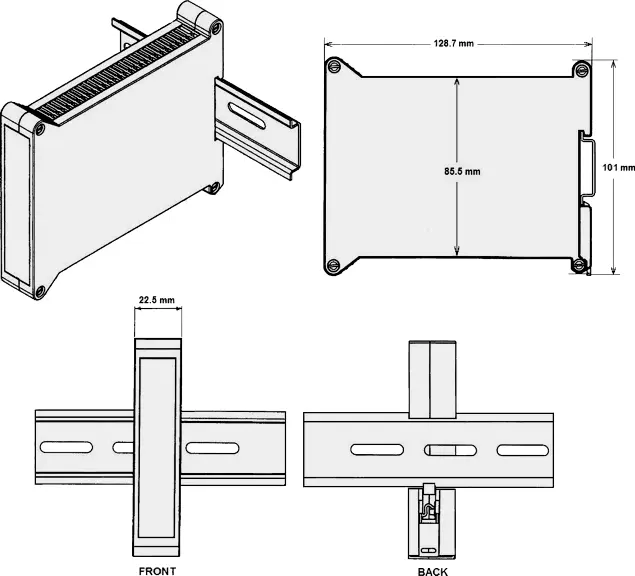
Dimensioned CAD assembly drawings in EPRT, STEP, x_t, .dwg, pdf file formats: Laureate-transmitter-case.zip (zipping prevents browser from opening CAD files as text files).
| Using Quadrature for Cutting to Length | |
|---|---|
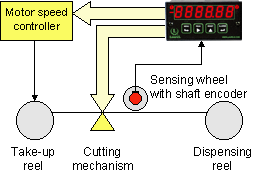 |
Controlling the repetitive cutting of material to length is an excellent application of a Laureate quadrature transmitter or Laureate quadrature digital panel meter. The quadrature encoder shares the shaft of a sensing wheel, whose rotation corresponds to lineal displacement of material. The transmitter compares the displacement reading against setpoint information, and then uses its dual relays to first slow down and then cut the material. |
| Using Quadrature for X-Y Positioning | |
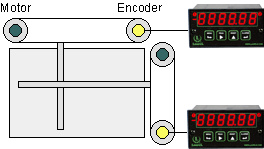 |
Accurate X-Y position or rate can be obtained from two shaft encoders, which convert linear position to quadrature signals as a shaft turns. In addition to serving as a transmitter, each Laureate transmitter or meter can use its optional dual relay setpoint capability for closed loop control. |
| Using Quadrature to Monitor a Drilling Operation | |
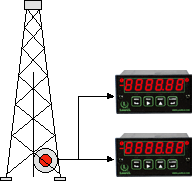 |
Quadrature can be used to track position and vertical drilling speed of the bit in an oil drilling operation. A shaft encoder is rotated by a cable that moves with the drilling shaft. In this application, the same encoder signal is applied to a Laureate quadrature transmitter for position, and to a second quadrature transmitter for rate. Both transmitters can send a 4-20 mA signal to a control room and be alarmed. In this application, quadrature provides much higher immunity to noise and jitter than a magnetic pickup. |
CBL02
USB-to-RS232 Adapter Cable
CBL04
RS232 Cable for LT Transmitters
Understanding the LTE DIN Rail Digital Transmitter with Ethernet Communication and Analog outputs for Bidirectional Position or Rate from Quadrature Encoders: Features, Functions, and Benefits
In the world of industrial automation and control, precision and reliability are paramount. The LTE Series DIN Rail Digital Transmitter stands out as a critical component designed to meet these high standards. This article delves into the specifics of this device, focusing on its features, functionalities, and the benefits it offers for bidirectional position or rate measurement using quadrature encoders.
What is the LTE DIN Rail Digital Transmitter?
The LTE Series DIN Rail Digital Transmitter is a sophisticated device used to convert signals from quadrature encoders into digital data that can be processed by industrial systems. Encoders are essential for accurately measuring the position or rate of rotating or linear components in various applications. The LTE Series enhances this capability by providing a reliable interface that translates these measurements into actionable information.
Key Features
-
DIN Rail Mounting: Designed for easy installation, the LTE Series transmitter is equipped for DIN rail mounting. This standard mounting method ensures that the device can be securely attached to control panels or enclosures, making it convenient for industrial environments.
-
Ethernet Communication: One of the standout features of the LTE Series is its Ethernet communication capability. This allows for seamless integration into networked systems, facilitating remote monitoring, control, and data acquisition. Ethernet connectivity also ensures high-speed data transmission and compatibility with modern industrial networks.
-
Analog Outputs: The device provides analog outputs that represent the measured position or rate. These outputs are crucial for interfacing with analog equipment or systems that require continuous data streams for monitoring or control purposes.
-
Bidirectional Measurement: The LTE Series is designed to handle bidirectional measurements, making it versatile for applications that require tracking movement in both directions. This feature is particularly useful in systems where components can move or rotate in both positive and negative directions.
-
Quadrature Encoder Compatibility: The transmitter is specifically tailored to work with quadrature encoders, which are known for their precision and reliability in capturing rotational or linear movement. Quadrature encoders provide two output signals that are 90 degrees out of phase, allowing for accurate position and speed measurement.
Benefits of the LTE DIN Rail Digital Transmitter
-
Enhanced Accuracy and Reliability: By converting encoder signals into digital data, the LTE Series ensures precise measurement and reliable performance. This accuracy is crucial in applications where even small deviations can lead to significant issues.
-
Integration with Modern Systems: The Ethernet communication feature allows for easy integration with contemporary industrial networks, enabling real-time data access and control. This integration facilitates advanced monitoring and analysis capabilities.
-
Versatility in Application: The bidirectional measurement capability and compatibility with quadrature encoders make the LTE Series suitable for a wide range of applications, from manufacturing and robotics to automated control systems.
-
Ease of Installation: The DIN rail mounting design simplifies the installation process, making it quick and straightforward to set up the transmitter in various industrial settings.
-
Continuous Data Monitoring: The analog outputs provide a continuous stream of data, allowing for real-time monitoring and control of the measured parameters. This feature is essential for systems that require constant feedback to maintain optimal performance.
Conclusion
The LTE Series DIN Rail Digital Transmitter is a versatile and reliable device designed to enhance industrial measurement and control systems. Its combination of Ethernet communication, analog outputs, and compatibility with quadrature encoders makes it a valuable tool for accurate bidirectional position or rate measurement. By integrating this transmitter into your system, you can achieve greater precision, ease of installation, and seamless connectivity, ultimately leading to improved operational efficiency and performance.
Where is an LTE DIN Rail Digital Transmitter with Ethernet Communication and Analog Outputs for Bidirectional Position or Rate from Quadrature Encoders Used?
In modern industrial automation and control systems, precision and flexibility are paramount. The LTE Series DIN Rail Digital Transmitter with Ethernet Communication and Analog Outputs for Bidirectional Position or Rate from Quadrature Encoders offers a sophisticated solution for these needs. But where exactly is such a device utilized, and what advantages does it offer? Let’s explore the applications and benefits of this advanced transmitter.
1. Industrial Automation
One of the primary applications of the LTE Series DIN Rail Digital Transmitter is in industrial automation systems. These transmitters are used to accurately monitor and control machinery and processes that involve rotational or linear movement. For instance, in conveyor systems, the transmitter can measure the position or speed of the conveyor belt, ensuring that products are processed at the correct rate and position.
2. Manufacturing Processes
In manufacturing, precision is critical. The LTE Series transmitter is employed in applications requiring exact measurement of position and rate from quadrature encoders. This is particularly useful in automated assembly lines where the positioning of parts or tools needs to be monitored and controlled with high accuracy to ensure product quality and operational efficiency.
3. Robotic Systems
Robotic systems often rely on precise control of position and rate to perform tasks accurately. The LTE Series DIN Rail Digital Transmitter can be integrated into robotic control systems to provide real-time feedback on the position and speed of robotic arms or other components. This feedback is crucial for tasks such as pick-and-place operations, welding, or painting, where precision and timing are essential.
4. Packaging Equipment
In packaging lines, where high-speed operations are common, the LTE Series transmitter helps in monitoring and controlling the speed and position of packaging machines. This ensures that packaging materials are fed, sealed, and cut correctly, reducing waste and increasing production efficiency.
5. Material Handling
Material handling systems, including those involving lifts, conveyors, and automated guided vehicles (AGVs), benefit from the use of the LTE Series transmitter. It helps in tracking the movement and speed of materials within a facility, ensuring smooth operation and preventing bottlenecks or collisions.
6. Energy and Utilities
In the energy and utilities sector, accurate measurement of position and rate is essential for managing various processes such as the operation of valves, pumps, and turbines. The LTE Series transmitter provides the necessary data for control systems to optimize performance and maintain operational stability.
7. Elevator and Escalator Systems
Elevators and escalators require precise control of position and speed to ensure safety and comfort. The LTE Series transmitter can be used to monitor and regulate these systems, providing real-time data to control the movement of the elevator car or escalator steps.
8. Research and Development
In R&D environments, where experiments and prototypes often involve complex mechanical systems, the LTE Series transmitter is valuable for collecting precise data on position and rate. This data is crucial for evaluating and optimizing the performance of new technologies and systems.
Advantages of the LTE DIN Rail Digital Transmitter
- Accuracy: The device offers high precision in measuring position and rate, which is essential for applications requiring exact control and monitoring.
- Versatility: With support for bidirectional position and rate measurements, the transmitter is adaptable to various applications.
- Communication: The Ethernet communication capability allows for seamless integration into modern industrial networks, enabling remote monitoring and control.
- Analog Outputs: The provision of analog outputs ensures compatibility with a wide range of control systems and data acquisition equipment.
- Ease of Integration: The DIN rail mounting design simplifies installation and integration into existing control panels or cabinets.
Conclusion
The LTE Series DIN Rail Digital Transmitter with Ethernet Communication and Analog Outputs is a versatile and precise device used across various industrial and commercial applications. Its ability to measure bidirectional position and rate from quadrature encoders makes it a valuable tool in maintaining the efficiency and accuracy of complex systems. Whether in manufacturing, robotics, packaging, or other sectors, this transmitter plays a crucial role in modern automation and control systems.
Less Information.








